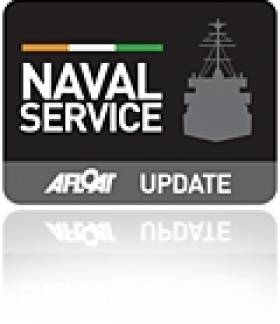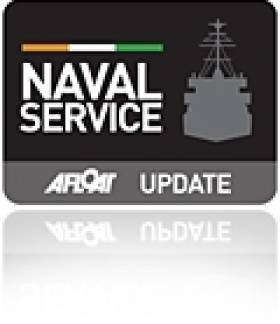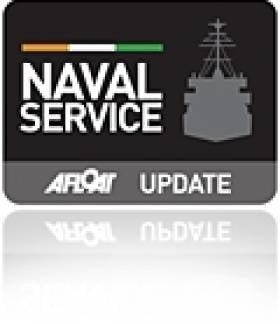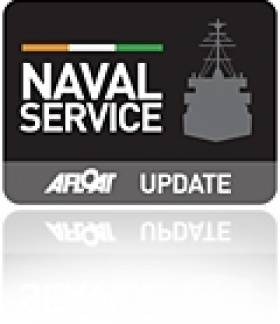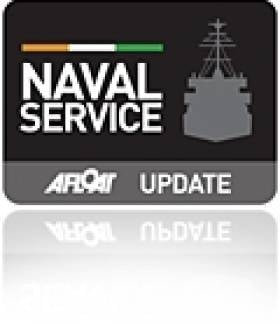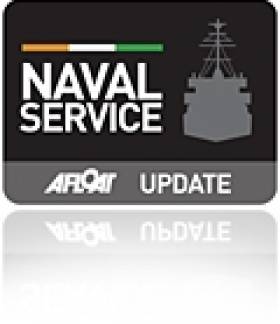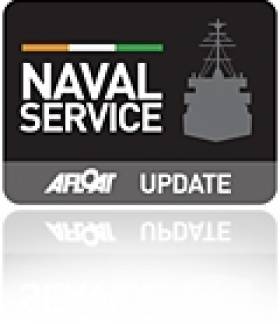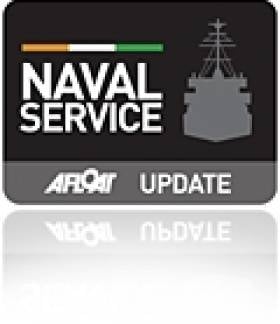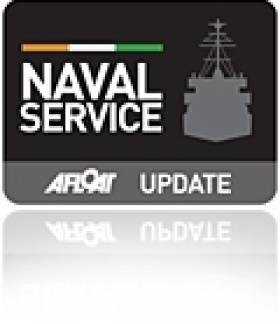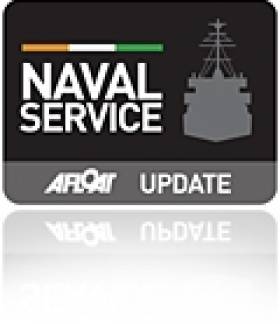Displaying items by tag: naval service
Devon-Built OPV L.E. Samuel Beckett Handed to Naval Service
#LEsamuelBeckett – The first of a pair of newbuild OPV's, the €50m (£41m) L.E. Samuel Beckett (P61) will be handed over to the Irish Naval Service at a Devon shipyard later, reports BBC News.
The 90m (295ft) offshore patrol vessel is the first completed ship to be built at Appledore Shipyard, near Bideford, since 2002.
The Naval Service ordered two vessels from the shipyard (Babcock Marine) in October 2010 for €99m (£81m). The second, to be name James Joyce (P62) is currently under construction. Samuel Beckett will be used for fisheries and coastal protection. For more from the BBC, click HERE to include an amidships photo of the newbuild class.
As previously reported on Afloat.ie, L.E. Samuel Beckett, the OPV 90 leadship or enhanced 'Roisin' class, carried out her shipbuilders sea-trails in the Bristol Channel, which earlier this month for example involved trials included a call offshore of Ifracombe on the North Devon coast and repeated circuits around Lundy Island.
L.E. Samuell Beckett was floated out last November from the builders hall dry-dock for the first time into the River Torridge. Asides her increased length another notable spot the difference, when taken at a glance is the enclosed bulky looking mainmast as distinct to the lattice structure of her predecessors.
It will be interesting see how her sister L.E. James Joyce will appear, should any minor or major design revisions be required when she is due for completion in 2015.
Last week L.E. Roisin (P51) detained a Spanish registered fishing vessel last week for alleged breaches of fishing regulations approximately 100 nautical miles south-west of Mizen Head.
Spanish Fishing Vessel Detained off Mizen Head
#TrawlerDetained – LÉ Roisin (P51) a Naval Service OPV detained a Spanish registered fishing vessel last week for alleged breaches of fishing regulations.
The fishing vessel was detained approximately 100 nautical miles south-west of Mizen Head and headed to Castletownbere, Co.Cork at the weekend and from where she was handed over to the Gardaí.
So far this year, the Naval Service have carried out 250 boardings and 17 warnings issued, and with the Spanish vessel becoming the third vessel detained for alleged infringements of fisheries regulations also in 2014.
#Asbestos – While carrying out routine maintenance of a Naval Service patrol vessel, it is now being claimed that 30 more civilian workers could also have been exposed to potentially lethal asbestos, writes The Irish Examiner.
That's in addition to another seven naval personnel who also have been exposed to the dust while they were working on the LÉ Ciara (P41) at the navy's headquarters in Haulbowline, Co Cork, last month.
The crisis deepened last night when Siptu said none of its civilian worker members, who are employed by the Department of Defence, had yet received any medical assessment — unlike the Naval Service personnel. To read much more on this story, the Irish Examiner has a report.
Naval Service Newbuild OPV L.E. Samuel Beckett Conducts Sea Trials in Bristol Channel
#LESamuelBeckett – The Naval Service newest newbuild OPV L.E. Samuel Beckett (P61) this week has undergone her shipbuilders sea-trails in the Bristol Channel, writes Jehan Ashmore.
The 1,900 tonnes OPV90 class 'enhanced Roisin class' which cost €49m was floated-out in November, carried out sea-trials and among her route included a call offshore of Ifracombe on the North Devon coast and around Lundy Island.
She returned yesterday to her builders, Babcock Marine in Appledore which is approached through the estuary of where the rivers Taw and Torridge meet. The shipyard is sited on the muddy tidal banks of the Torridge, which flows downriver from nearby Bideford.
#SamuelBeckett – At first glance L.E. Samuel Beckett (P61), the first of a pair of longer (90m) newbuild OPV's which was floated-out at Babcock Marine's Appledore shipyard in November, displays a notably larger mast compared to her predecessors, writes Jehan Ashmore.
Images of the €49m L.E. Samuel Beckett reported on the North Devon Gazette, show her leaving the enclosed shipyard on 3 November and berth alongside the tidal quay of the north Devon facility. It is understood that work on her sister, L.E. James Joyce (P62) started the following day.
Since these photos of L.E. Samuel Beckett were taken, the fitting of the mast between the funnel and the wheelhouse has been added (see photo) and this this mainmast is covered in rather than the lattice structure of L.E.Niamh (P52) see photo. She is the last ship built for the navy and is seen berthed at the Naval Service base at Haulbowline, Cork Harbour.
L.E. Samuel Beckett has new state-of-the-art technology features among them robotic submersibles and a historic first for the navy, drones or "unmanned aerial surveillance vehicles".
She is an enhanced version of the 78m long 'leadship' class the L.E. Roisin (P51) and sister L.E. Niamh (P52) which are themselves based on a design from STX Canada Marine (formerly Kvaerner Masa Marine).
The all-steel hull (see L.E. Niamh in rough weather) is based on the Mauritian Vigilant patrol vessel launched in 1995, but without the helicopter deck and hangar facilities. The newbuilds are designed with longer hulls for better sea-keeping qualities so to cope better in rough sea states particularly those in the Atlantic.
As of previous reports, L.E. Samuel Beckett was then expected to be delivered to the Naval Service base in Cork this month or at least within the first quarter of 2014.
In the meantime, her direct predecessor, the former OPV L.E. Emer (P21) which was decommissioned last year following a service of more than 35 years, still remains in Cork Dockyard for new Nigerian owners, Uniglobe Group who plan to use her on the Niger Delta.
Irish Naval Service Divers Get Hand Held Sonar & Navigation System
#navy – The Irish Navy has acquired a 'Navigator Diver Held Sonar and Navigation System' manufactured by Shark Marine Technologies Inc. of Ontario, Canada. The navy divers believe the system equipped with forward-looking multi-beam sonar will assist them in their diving operations, in particular in search and recovery operations and underwater security.
The Naval Service Diving Section (NSDS) is the primary State diving team, carrying out varied tasks for a number of State Agencies.
Members of the NSDS used the NAVIGATOR system while training with the Royal Canadian Navy's fleet diving unit, according to the Ottawa Citizen newspaper.
The device is used in ship hull inspections as well as to assist local civilian authorities in searching for drowning victims and underwater criminal evidence.
The use of the Navigators can, according to Shark marine, enhance the divers' situational awareness, their area coverage rate, and their personal safety by providing them with real time information regarding position, depth and heading, as well as an extended visual range through the use of an imaging sonar.
The Ottawa Citizen has more on this story here
New Flag Officer for Naval Service
#FlagOfficer- The Irish Times writes that a new flag officer, Cmdr Hugh Tully who has 36 years experience with the Naval Service has been appointed.
Cmdr Tully takes over the role of Flag Officer Commanding Naval Service from Rear Admiral Mark Mellett, who as previously reported on Afloat.ie, was promoted last month to Defence Forces deputy chief of staff – the first time a Naval Service officer has held this senior position.
Cmdr Tully was Officer Commanding Naval Operations at Naval Base in Haulbowline, Cork. He has commanded the flagship L.É. Eithne (P31), L.É. Aoife (P22) and L.É. Orla (P41). Tully also received award medals for overseas service in Isreal and Lebanon with UNIFIL (1986) and UNTSO (2003-2005).
His appointment comes as the service is due to take delivery of two new OPV vessels, the first Afloat.ie adds the L.É. Samuel Beckett was 'floated-out' last month at a shipyard in north Devon.
Second Fishing Detention by L.E. Aoife off Cork Coast
#TrawlerDetained – An Irish registered fishing vessel was detained by the Naval Service OPV OPV L.É. Aoife (P22) on Wednesday approximately 40 nautical miles South East of Cork.
The detention was in relation to an alleged breach of fishing regulations. This is the second detention carried out by L.É. Aoife this week when a UK registered fishing vessel was involved and also off the Cork coastline.
The latest detained vessel is being escorted by to Cobh, it is expected to arrive alongside tonight, where it will be handed over to An Gardaí Síochána.
In total the Naval Service has boarded 931 vessels and this is the 15th vessel detained by the Naval Service so far this year.
UK Registered Trawler Detained by Naval Service
#TrawlerDetained – The Naval Service OPV L.É. Aoife (P22) detained a fishing vessel registered in the UK approximately 70 nautical miles south of Cork.
The detention was in relation to an alleged breach of fishing regulations.
According to the Naval Service the vessel was in the process of being handed over to the UK Maritime Management Office and expected to leave Irish waters and return to a UK port last night.
This latest incident brings to 926 the total number of vessels boarded by the navy in 2013 and the fourteenth vessel detained so far this year.
Former Atlantic Dawn Supertrawler Detained in Irish Waters
#Supertrawler - The Irish Times writes that the Naval Service OPV LÉ Roisín (P51) has detained one of the world's largest fishing vessels, the former Irish flagged Atlantic Dawn , for alleged infringements in Irish waters.
The 144-metre supertrawler, which is now Dutch-owned and registered and renamed as Annelies Ilena , was escorted into the vessels former homeport of Killybegs, Co Donegal, last night as part of a joint Naval Service - Sea Fisheries Protection Authority (SFPA) surveillance operation.
The vessel, which is the largest ever detained in an exercise of this type in Irish waters, was handed over to the Garda Siochána for suspected infringements relating to "high grading" of fish.
According to the Naval Service this vessel is the largest ever detained by the Naval Service and is considered to be one of the largest fishing vessels in the world. The detention of Annalies Ilena brings to 922 the number of boardings conducted this year by the Naval Service and this is the thirteenth vessel detained for alleged infringements of fisheries regulations in 2013.


























